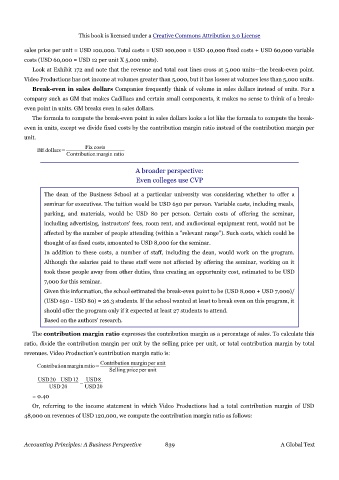Page 838 - Accounting Principles (A Business Perspective)
P. 838
This book is licensed under a Creative Commons Attribution 3.0 License
sales price per unit = USD 100,000. Total costs = USD 100,000 = USD 40,000 fixed costs + USD 60,000 variable
costs (USD 60,000 = USD 12 per unit X 5,000 units).
Look at Exhibit 172 and note that the revenue and total cost lines cross at 5,000 units—the break-even point.
Video Productions has net income at volumes greater than 5,000, but it has losses at volumes less than 5,000 units.
Break-even in sales dollars Companies frequently think of volume in sales dollars instead of units. For a
company such as GM that makes Cadillacs and certain small components, it makes no sense to think of a break-
even point in units. GM breaks even in sales dollars.
The formula to compute the break-even point in sales dollars looks a lot like the formula to compute the break-
even in units, except we divide fixed costs by the contribution margin ratio instead of the contribution margin per
unit.
Fix costs
BE dollars=
Contribution margin ratio
A broader perspective:
Even colleges use CVP
The dean of the Business School at a particular university was considering whether to offer a
seminar for executives. The tuition would be USD 650 per person. Variable costs, including meals,
parking, and materials, would be USD 80 per person. Certain costs of offering the seminar,
including advertising, instructors' fees, room rent, and audiovisual equipment rent, would not be
affected by the number of people attending (within a "relevant range”). Such costs, which could be
thought of as fixed costs, amounted to USD 8,000 for the seminar.
In addition to these costs, a number of staff, including the dean, would work on the program.
Although the salaries paid to these staff were not affected by offering the seminar, working on it
took these people away from other duties, thus creating an opportunity cost, estimated to be USD
7,000 for this seminar.
Given this information, the school estimated the break-even point to be (USD 8,000 + USD 7,000)/
(USD 650 - USD 80) = 26.3 students. If the school wanted at least to break even on this program, it
should offer the program only if it expected at least 27 students to attend.
Based on the authors' research.
The contribution margin ratio expresses the contribution margin as a percentage of sales. To calculate this
ratio, divide the contribution margin per unit by the selling price per unit, or total contribution margin by total
revenues. Video Production's contribution margin ratio is:
Contribution margin per unit
Contribution margin ratio=
Selling price per unit
USD20 – USD12 – USD8
USD 20 USD20
= 0.40
Or, referring to the income statement in which Video Productions had a total contribution margin of USD
48,000 on revenues of USD 120,000, we compute the contribution margin ratio as follows:
Accounting Principles: A Business Perspective 839 A Global Text

